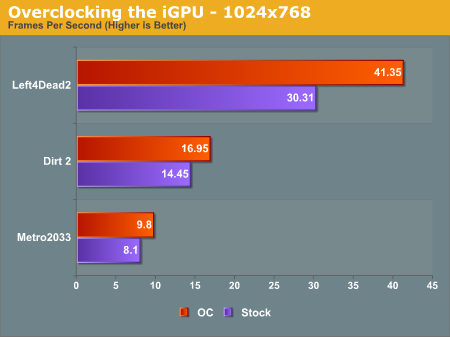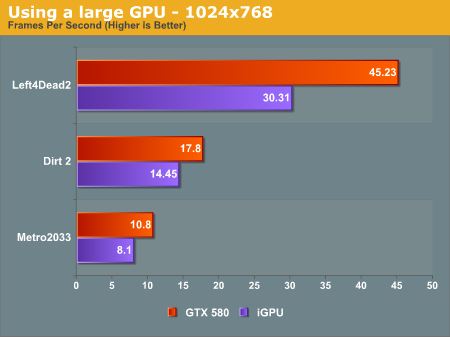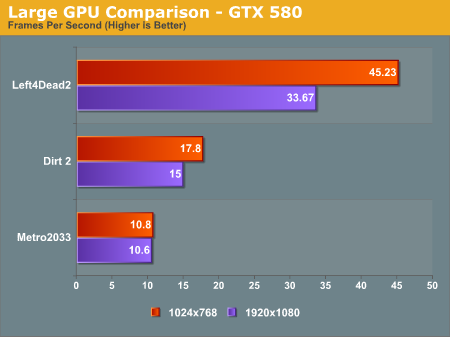Fusion E-350 Review: ASUS E35M1-I Deluxe, ECS HDC-I and Zotac FUSION350-A-E
by Ian Cutress on July 14, 2011 11:00 AM ESTI decided to dedicate an extra page to looking at two features on these Fusion boards that are, in my eyes, quite interesting to discuss.
On the one hand, we are dealing with low power CPUs which can't process that much very fast, so if you want to overclock them, that overclock also has a significant impression on any integrated GPU gaming being used.
On the other, we have access to a PCIe x16 slot, capable of running a full length, high-end GPU (should you want to). This PCIe slot actually runs at 4x, which in certain circumstances would cripple the discrete GPU. Pair this crippling with a not-so-great CPU, and we're not expecting the gaming capability to take off, so I've examined this as well.
Overclocking, and Gaming Performance
By default, we have a 1600 MHz, dual core Fusion CPU, combined with an 80 SP iGPU at 500 MHz, designated the HD 6310. In terms of pure CPU throughput, we saw on all boards that a percentage increase in clock speed gave a direct increase in benchmark result for the 3D Particle Movement benchmark.
In terms of gaming, we need to analyze what this overclock does. Apart from the default CPU speed increase, we're getting a direct GPU clock speed increase as well. The DDR3 memory is also getting an increase, thus the memory bandwidth to the iGPU is increased as well. So any overclock will increase its own effectiveness in two major areas.
I'll take the ASUS E35M1-I Deluxe for this explanation, which allowed a 10% overclock from 1600 MHz to 1760 MHz. From the gaming perspective on the iGPU, we have a large increase in scores:


Out largest increase was in the DirectX 9 game, Left4Dead2 - a staggering 36.4 % increase in frame rate from 30.3 fps to 41.4 fps, making the game more playable at the 1024x768 resolution. Even Metro2033 had a 21.0 % increase, and Dirt2 a 17.3% increase. Is the iGPU itself capable of playing the major games? Probably not, but at least those older ones can feel smoother.
The PCIe slot running at 4x - Is it worth using a beefy GPU, like a GTX 580?
The short answer is no, probably not. Normally we see a full length PCIe slot run at 4x only when it's the second or third PCIe slot on the board, and usually at the detriment to SATA or USB ports that have to be switched off as a result. Here, we have two main issues - will the CPU be fast enough to be able to navigate data across the PCIe bus to and from the discrete graphics, or will the 4x speed of the bus be the crippling factor?
(Note: I understand getting a GTX580 isn't realistic with a Fusion, but it's the most powerful GPU I have to hand and most apt for this test as GPU power should not be an issue.)
For this test, I ran the GTX 580 at the same settings as the iGPU tests, and then at the 1920x1080 resolutions and settings that we normally do for the high end motherboards (8xMSAA, 16xAF). First, at the iGPU resolutions on the ASUS E35M1-I Deluxe:

Despite using a $500 GPU, our biggest increase in frame rate, at 1024x768 resolution, is only 50%. In Left4Dead2 on Sandy Bridge, at 1680x1050, we see over 200 fps - we know L4D2 can be fairly CPU limited, so the fact that we only see 45 fps is definitely testament to the Fusion CPU.
Now, at the full 1920x1080 resolution:

In Metro 2033, we didn't see any real decline from 1024x768 to 1920x1080, but there was a significant drop in Left4Dead2. These results are also due to the CPU holding the GPU back, meaning that even with a GTX 580 on Fusion, only the old games will be playable, but this time at a higher resolution.










67 Comments
View All Comments
ET - Saturday, July 16, 2011 - link
Here are a few links to E-350 reviews using a desktop PSU. Not a comprehensive list by any means:http://www.guru3d.com/article/amd-brazos-platform-...
http://www.overclockersclub.com/reviews/sapphire_f...
http://www.xbitlabs.com/articles/mainboards/displa...
http://www.eteknix.com/motherboards/jetway-nc85-e3...
http://www.tweaktown.com/reviews/4093/asus_e35m1_i...
And of course Anandtech's first review of the platform:
http://www.anandtech.com/show/4134/the-brazos-revi...
ET - Friday, July 15, 2011 - link
In the conclusion you say about the ECS: "Having 33% free of anything is usually a good idea, so when it comes part of the package with very little increase in power consumption, it is a good thing. As a result, all the benchmarks and all the games had much, much higher scores than the other boards we tested."Unfortunately these gaming performance figures don't appear in the article. This looks like an oversight that needs to be corrected.
Mitalca - Friday, July 15, 2011 - link
I second that.Through the review there's a lot of times when Ian talks about the marvell the ECS did with the 33% OC. Then why you didn't show the results?
One of the bigest flaws in this review, that make a lot of people suspect of a way-too-much-biased review.
Testing with a 580 is ridiculous, even if you want to "provide a plausible maximum ceiling". I spend $500 and I only get 50% more frames. What about a U$ 50-100 gpu?? If the CPU and the memory are by far the bottleneck, we should see similar results.
And, once you show the huge benefits that overclocking does to the iGPU, why not try it with the dGPU?
ET - Saturday, July 16, 2011 - link
The main thing I would like to see added to the discrete GPU test is an AMD GPU. The CPU usage of NVIDIA and AMD drivers are different, so results may be different.I don't think that a discrete GPU is worth using with the E-350 in any case, and the test with the GeForce 580 pretty much proved that. It's just too CPU limited.
xorbit - Friday, July 15, 2011 - link
This review is a steaming pile. At least it lends credibility that Anandtech might not be biased, just woefully incompetent.An HTPC review without HTPC benchmarks and coupling the chips with impropper PSU/GPUs.
silverblue - Friday, July 15, 2011 - link
Without wanting to start a huge squabble, if you guys think you could do better...lestr - Friday, July 15, 2011 - link
Tom's already did: Daily Hardware 7/6. 8 boards with more relevant tests though somewhat incomplete.My big question is: WHAT is AMD afraid of? SUCCESS? AMD fanboy but when they could really kick a** they give us another "almost".
Another question: Does the PCIe slot support anything other than graphics? Can I stuff a Hauppauge 2250 or a Ceton card in it? This is totally ignored on almost ALL current ITX boards. You're about as likely to win the Kentucky Derby with a 3-legged horse as playing any games on this platform. What's the point?
The E450 (1.65 / 1333 / HD 6320) is due out any time. Standards on this platform should include 6 audio outs (hello Asus!), mPCIe, fp USB3.. how about DUAL channel memory? What's a few more watts anyway? Is 35W APU too many? RAID?
I wish AMD would pull out all the stops and do this little thing right.. entice the partners as well. If they can't do anything else but bury Atom/NV ... AMD needs to win something sometime.. why not NOW?
Any comments, Ian?
mino - Friday, July 15, 2011 - link
Brazos is sigle channle.There are 35W Llano E2 series APU's on the way.
Brazos is SOLD OUT for 3 quarters allready ... talk about AMD being afraid ...
medi01 - Sunday, July 17, 2011 - link
Idiot detected.Wander7 - Friday, July 15, 2011 - link
Just by looking at the two heatsinks and not doing any measurements, it looks like the Asus' heatsink is suffering from air stagnation because the fins are too close together....